Wildflowers, Grasses and Other Nonwoody Plants
Media

Species Types
Scientific Name
Ipomoea pandurata
Description
Wild potato vine is related to the sweet potatoes we buy at grocery stores. This native vine is also related to the morning glories that decorate trellises and to the bindweed that plagues gardeners and farmers.
Media

Species Types
Scientific Name
Solanum carolinense
Description
Horse nettle is a native perennial with spiny stems and leaves, white to purplish flowers, and toxic fruits that look like tiny yellow tomatoes. It does well in disturbed habitats, and many people consider it a weed.
Media
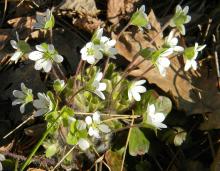
Species Types
Scientific Name
Anemone americana (syn. Hepatica nobilis var. obtusa)
Description
One of seven species of windflowers, or anemones in Missouri, liverleaf or round-lobed hepatica occurs in the eastern and southern portions of the Ozarks. It's a hairy plant with one flower per stalk; flowers may be white, pink, blue, or lavender.
Media
Species Types
Scientific Name
Anagallis arvensis (Lysamachia arvensis)
Description
The scarlet pimpernel, a native of Europe, is a tender annual with scarlet or brick-red flowers that close around 4 p.m., or whenever clouds shade the sun. When the sun comes out again, they reopen.
Media

Species Types
Scientific Name
Calystegia sepium (also Convolvulus sepium)
Description
Instantly recognizable as a type of morning glory, hedge bindweed is common in disturbed habitats and can be a serious agricultural weed, but it is not as problematic as its relative field bindweed.
Media
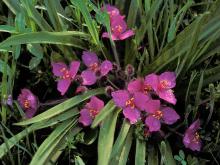
Species Types
Scientific Name
Tradescantia longipes
Description
Dwarf spiderwort is a low-growing perennial with bright magenta, purple, or purplish-blue flowers with three petals arranged in a triangular pattern. It blooms in Ozark woodlands in April and May.
Media
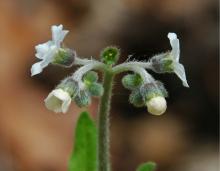
Species Types
Scientific Name
Cynoglossum virginianum
Description
Wild comfrey has large basal leaves that are soft, hairy, and elliptical with long petioles — they look like hounds’ tongues! The upright flowering stalk has few leaves and looks like a wand.
Media
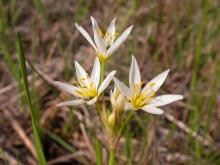
Species Types
Scientific Name
Nothoscordum bivalve
Description
False garlic looks like a wild garlic or onion plant, but it doesn’t smell like one. The flowers can be white, yellowish, or greenish, and they appear in spring and sometimes also fall.
Media
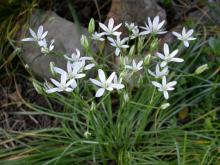
Species Types
Scientific Name
Ornithogalum umbellatum
Description
Star of Bethlehem is an introduced exotic plant that makes clusters of bright white flowers in the spring. It reproduces prolifically by forming a multitude of bulbs underground.
Media
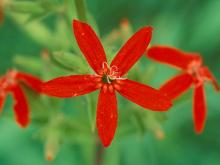
Species Types
Scientific Name
Silene regia
Description
A spectacular plant of the tallgrass prairie, royal catchfly is threatened by habitat destruction and degradation throughout its range. Missouri has most of the world's populations of this noble plant.
See Also
About Wildflowers, Grasses and Other Nonwoody Plants in Missouri
A very simple way of thinking about the green world is to divide the vascular plants into two groups: woody and nonwoody (or herbaceous). But this is an artificial division; many plant families include some species that are woody and some that are not. The diversity of nonwoody vascular plants is staggering! Think of all the ferns, grasses, sedges, lilies, peas, sunflowers, nightshades, milkweeds, mustards, mints, and mallows — weeds and wildflowers — and many more!





















